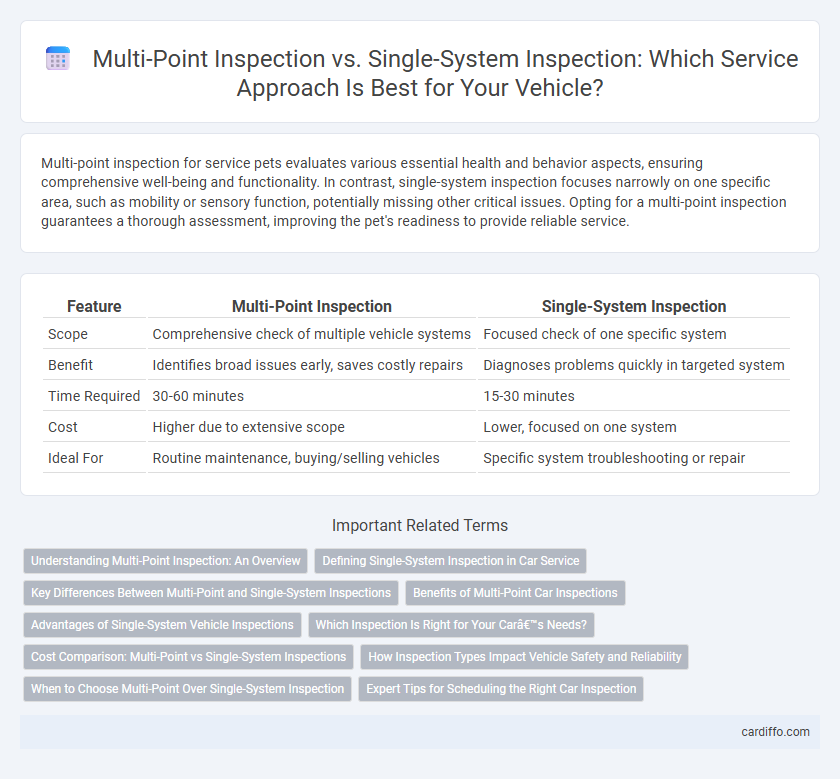Multi-point inspection for service pets evaluates various essential health and behavior aspects, ensuring comprehensive well-being and functionality. In contrast, single-system inspection focuses narrowly on one specific area, such as mobility or sensory function, potentially missing other critical issues. Opting for a multi-point inspection guarantees a thorough assessment, improving the pet's readiness to provide reliable service.
Table of Comparison
| Feature | Multi-Point Inspection | Single-System Inspection |
|---|---|---|
| Scope | Comprehensive check of multiple vehicle systems | Focused check of one specific system |
| Benefit | Identifies broad issues early, saves costly repairs | Diagnoses problems quickly in targeted system |
| Time Required | 30-60 minutes | 15-30 minutes |
| Cost | Higher due to extensive scope | Lower, focused on one system |
| Ideal For | Routine maintenance, buying/selling vehicles | Specific system troubleshooting or repair |
Understanding Multi-Point Inspection: An Overview
Multi-point inspection involves a comprehensive evaluation of multiple vehicle systems, ensuring a thorough assessment of engine, brakes, suspension, and electrical components. This method identifies potential issues across various subsystems, improving overall vehicle reliability and safety. Compared to single-system inspection, multi-point inspection provides a broader scope, detecting interconnected problems that might otherwise be overlooked.
Defining Single-System Inspection in Car Service
Single-system inspection in car service involves a thorough evaluation of one specific vehicle component or system, such as the braking system or engine performance. This focused approach allows technicians to identify and address issues precisely within that particular area, ensuring targeted repairs and maintenance. Single-system inspection is especially useful when symptoms indicate a problem localized to one system, enhancing diagnostic accuracy and efficiency.
Key Differences Between Multi-Point and Single-System Inspections
Multi-point inspection covers multiple vehicle systems such as brakes, tires, fluids, and engine components, providing a comprehensive assessment, while single-system inspection targets a specific area like the transmission or exhaust for focused diagnostics. Multi-point inspections help detect potential issues early across various systems, enhancing overall vehicle safety and performance, whereas single-system inspections offer detailed analysis for repair or maintenance of identified problems. Choosing between the two depends on the vehicle's condition, service history, and specific maintenance needs.
Benefits of Multi-Point Car Inspections
Multi-point car inspections offer comprehensive diagnostics by evaluating multiple systems, leading to early detection of potential issues and preventing costly repairs. This thorough approach enhances vehicle safety, ensures better performance, and extends the lifespan by addressing wear and tear across brakes, tires, fluids, and engine components. Compared to single-system inspections, multi-point services provide a holistic assessment, delivering greater value and peace of mind for vehicle owners.
Advantages of Single-System Vehicle Inspections
Single-system vehicle inspections allow technicians to concentrate on one specific system, ensuring a highly detailed and precise evaluation that can identify subtle issues often missed in broader checks. This targeted approach reduces inspection time and minimizes service costs while enhancing diagnostic accuracy for critical vehicle components such as brakes, suspension, or engine systems. Prioritizing single-system inspections enables proactive maintenance and extends the lifespan of vital vehicle parts by addressing problems early.
Which Inspection Is Right for Your Car’s Needs?
Multi-point inspection provides a comprehensive evaluation by examining multiple systems in your vehicle, ensuring early detection of potential issues across brakes, tires, fluids, and engine performance. Single-system inspection targets a specific area, ideal for addressing known problems or system-specific maintenance like transmission or air conditioning checks. Choosing between these depends on your car's age, mileage, and service history, with multi-point ideal for routine maintenance and single-system best for focused diagnostics.
Cost Comparison: Multi-Point vs Single-System Inspections
Multi-point inspections typically cost more upfront compared to single-system inspections due to the comprehensive evaluation of multiple vehicle components. However, multi-point inspections can identify potential issues early, potentially reducing long-term repair costs and enhancing vehicle reliability. In contrast, single-system inspections are less expensive initially but may lead to higher expenses if other vehicle systems experience unnoticed failures.
How Inspection Types Impact Vehicle Safety and Reliability
Multi-Point Inspection evaluates various vehicle systems including brakes, tires, fluids, and engine components, providing a comprehensive assessment that enhances overall safety and reliability. Single-System Inspection targets one specific area, such as the braking system or transmission, which may overlook potential issues in other critical components. Choosing Multi-Point Inspection reduces the risk of unexpected breakdowns and ensures all interconnected vehicle systems function optimally for safer driving conditions.
When to Choose Multi-Point Over Single-System Inspection
Choosing a multi-point inspection over a single-system inspection is essential when dealing with complex machinery or vehicles that have interconnected systems requiring thorough evaluation to prevent overlooked issues. Multi-point inspections provide a comprehensive overview by examining various components simultaneously, reducing the risk of future breakdowns and costly repairs. Opt for multi-point inspections during routine maintenance, pre-purchase evaluations, or after experiencing multiple system symptoms to ensure overall safety and optimal performance.
Expert Tips for Scheduling the Right Car Inspection
Scheduling a multi-point inspection provides a comprehensive overview of your vehicle's condition by assessing multiple systems such as brakes, engine, transmission, and suspension, ensuring early detection of potential issues. In contrast, a single-system inspection focuses on one specific area, ideal for diagnosing known problems or routine checks like brake or tire inspections. Expert tips recommend choosing a multi-point inspection during regular maintenance intervals to prevent costly repairs, while single-system inspections should be scheduled when symptoms or alerts indicate a targeted concern.
Multi-Point Inspection vs Single-System Inspection Infographic

 cardiffo.com
cardiffo.com